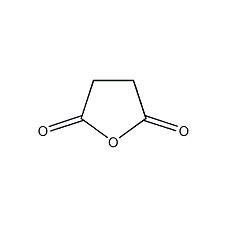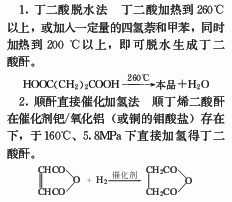
Structural formula
| Business number | 02WU |
|---|---|
| Molecular formula | C4H4O3 |
| Molecular weight | 100 |
| label |
Succinic anhydride, 2,5-Tetrahydrofurandione, Tetrahydrofuran-2,5-dione, Butanedioic anhydride, Succinyl anhydride, 2,5-Diketotetrahydrofuran, Aliphatic carboxylic acids and their derivatives, acidic solvent |
Numbering system
CAS number:108-30-5
MDL number:MFCD00005525
EINECS number:203-570-0
RTECS number:WN0875000
BRN number:108441
PubChem number:24854387
Physical property data
1. Properties: Colorless rhombic prism needle-like or flaky crystals. Sensitive to moisture.
2. Density (g/mL, 25℃): 1.234
3. Relative vapor density (g/mL, air=1): 3.5
4. Melting point (ºC): 120
5. Boiling point (ºC, normal pressure): 261
6. Relative density (20℃, 4℃): 1.2340
7. Refractive index (D20): 1.47
8. Flash point (ºC): 157
9. The standard heat of combustion (enthalpy) of the crystal phase (kJ·mol-1): -1538.1
10. The standard heat (enthalpy) of the crystal phase (kJ·mol-1): -607.6
11. Vapor pressure (mmHg, 92ºC): 1
12. Saturated vapor pressure (kPa, ºC): Undetermined
13. Heat of combustion (KJ/mol): Undetermined
14. Critical temperature (ºC): Undetermined
15. Critical pressure (KPa) : Undetermined
16. Log value of oil-water (octanol/water) partition coefficient: Undetermined
17. Explosion upper limit (%, V/V): Undetermined
p>
18. Lower explosion limit (%, V/V): Undetermined
19. Solubility: Slightly soluble in water and ether, soluble in chloroform, carbon tetrachloride, and ethanol.
Toxicological data
1. Skin/eye irritation
Standard Draize test: rabbit, eye contact: 750μg, severity of reaction: severe.
2. Acute toxicity: Rat oral LD50: 1510mg/kg;
3. Other multiple dose toxicity: Rat oral TDLo: 13mg/kg/13W-I; Rat oral TDLo: 2618mg/kg/20D-I; mouse oral TDLo: 10500mg/kg/16D-I; mouse oral TDLo: 19500mg/kg/13W-I;
4 , Chronic toxicity/carcinogenicity
Rat subcutaneous TDLo: 2600mg/kg/65W-I;
5. Reproductive toxicity
Mouse intraperitoneal TDLo : 79mg/kg (8-10 days after conception in female rats);
6. Mutagenicity
Escherichia coli gene mutation test: 2mg/L;
Ecological data
None
Molecular structure data
1. Molar refractive index: 20.31
2. Molar volume (cm3/mol): 72.7
3. Isotonic specific volume (90.2K ): 191.2
4. Surface tension (dyne/cm): 47.7
5. Polarizability (10-24cm3): 8.05
Compute chemical data
1. Reference value for hydrophobic parameter calculation (XlogP): -0.5
2. Number of hydrogen bond donors: 0
3. Number of hydrogen bond acceptors: 3
4. Number of rotatable chemical bonds: 0
5. Number of tautomers: 3
6. Topological molecule polar surface area 43.4
7. Number of heavy atoms: 7
8. Surface charge: 0
9. Complexity: 102
10. Number of isotope atoms: 0
11. Determine the number of atomic stereocenters: 0
12. Uncertain number of atomic stereocenters: 0
13. Determine the number of chemical bond stereocenters: 0
14. Number of uncertain chemical bond stereocenters: 0
15. Number of covalent bond units: 1
Properties and stability
1. This product has low toxicity. When handling hot succinic acid or anhydride during production, activated carbon gas masks and gloves should be worn to prevent irritation of mucous membranes and skin burns.
2. Exist in oriental tobacco leaves and smoke.
Storage method
1. Store sealed in a cool and ventilated place.
2. Packed in plastic bags lined with plastic bags and woven bags coated. Net weight 25kg. Store and transport according to general chemical regulations.
Synthesis method

3. Tobacco: OR, 18.
4. Obtain orthorhombic prisms from absolute ethanol.
Purpose
The pharmaceutical industry is used to manufacture analgesics, diuretics, analgesics, antipyretics and anti-inflammatory, contraceptive, anti-cancer and other drugs. The dye industry is small and can be used as raw material for synthetic dyes after hydrolysis. The synthetic resin industry is used to manufacture alkyd resins and ion exchange resins. The plastics industry uses it to make fiberglass reinforced plastics. The pesticide industry is used to create plant growth regulators and more. In the organic industry, it is used as an intermediate for the synthesis of organic compounds. Used as alkali titration standard in analytical chemistry.


